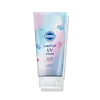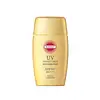What's inside
What's inside
 Key Ingredients
Key Ingredients

 Benefits
Benefits

 Concerns
Concerns

 Ingredients Side-by-side
Ingredients Side-by-side

Water
Skin ConditioningEthylhexyl Methoxycinnamate
UV AbsorberAlcohol Denat.
AntimicrobialDiphenylsiloxy Phenyl Trimethicone
Skin ConditioningZinc Oxide
Cosmetic ColorantCaprylic Acid
CleansingC12-15 Alkyl Benzoate
AntimicrobialBis-Ethylhexyloxyphenol Methoxyphenyl Triazine
Skin ConditioningCetyl Ethylhexanoate
EmollientTitanium Dioxide
Cosmetic ColorantDiethylamino Hydroxybenzoyl Hexyl Benzoate
UV FilterDierucic Acid
Skin ConditioningButylene Glycol
HumectantDipropylene Glycol
HumectantGlycerin
HumectantAscorbic Acid
AntioxidantSodium Hyaluronate
HumectantSimmondsia Chinensis Seed Oil
EmollientCitrus Junos Fruit Extract
Skin ConditioningCitrus Limon Juice
Skin ConditioningCitrus Limon Fruit Extract
MaskingBHT
AntioxidantPEG-10 Castor Oil
EmulsifyingPEG-80 Hydrogenated Castor Oil
EmulsifyingAcrylates/Beheneth-25 Methacrylate Copolymer
Dimethicone/Phenyl Vinyl Dimethicone Crosspolymer
Ethylhexyl Triazone
UV AbsorberXanthan Gum
EmulsifyingCyclopentasiloxane
EmollientSilica
AbrasiveStearoyl Inulin
EmollientTriethoxycaprylylsilane
Polyhydroxystearic Acid
EmulsifyingLauroyl Lysine
Skin ConditioningSynthetic Fluorphlogopite
Tin Oxide
AbrasiveAluminum Hydroxide
EmollientSodium Hydroxide
BufferingPhenoxyethanol
PreservativeMethylparaben
PreservativeParfum
MaskingMica
Cosmetic ColorantWater, Ethylhexyl Methoxycinnamate, Alcohol Denat., Diphenylsiloxy Phenyl Trimethicone, Zinc Oxide, Caprylic Acid, C12-15 Alkyl Benzoate, Bis-Ethylhexyloxyphenol Methoxyphenyl Triazine, Cetyl Ethylhexanoate, Titanium Dioxide, Diethylamino Hydroxybenzoyl Hexyl Benzoate, Dierucic Acid, Butylene Glycol, Dipropylene Glycol, Glycerin, Ascorbic Acid, Sodium Hyaluronate, Simmondsia Chinensis Seed Oil, Citrus Junos Fruit Extract, Citrus Limon Juice, Citrus Limon Fruit Extract, BHT, PEG-10 Castor Oil, PEG-80 Hydrogenated Castor Oil, Acrylates/Beheneth-25 Methacrylate Copolymer, Dimethicone/Phenyl Vinyl Dimethicone Crosspolymer, Ethylhexyl Triazone, Xanthan Gum, Cyclopentasiloxane, Silica, Stearoyl Inulin, Triethoxycaprylylsilane, Polyhydroxystearic Acid, Lauroyl Lysine, Synthetic Fluorphlogopite, Tin Oxide, Aluminum Hydroxide, Sodium Hydroxide, Phenoxyethanol, Methylparaben, Parfum, Mica
Cyclomethicone
EmollientWater
Skin ConditioningAlcohol Denat.
AntimicrobialZinc Oxide
Cosmetic ColorantEthylhexyl Methoxycinnamate
UV AbsorberIsododecane
EmollientPEG-3 Dicaprylate/Caprate
EmulsifyingPolysilicone-15
UV FilterPolymethylsilsesquioxane
Isononyl Isononanoate
EmollientHydroxyethyl Dimethicone
Butylene Glycol
HumectantAnthemis Nobilis Flower Extract
MaskingHematite Extract
Skin ProtectingShilajit Extract
Sus Extract
Skin ConditioningCirsium Flower/Leaf/Stem Extract
Skin ConditioningSalvia Officinalis Extract
AntimicrobialPanax Ginseng Flower Extract
AntioxidantTocopherol
AntioxidantSodium Hyaluronate
HumectantRosa Rugosa Flower Extract
Skin ConditioningFucus Vesiculosus Extract
EmollientSoluble Collagen
HumectantBHT
AntioxidantDisodium EDTA
PEG-9 Polydimethylsiloxyethyl Dimethicone
EmulsifyingSqualane
EmollientCetyl Dimethicone
EmollientTrimethylsiloxysilicate
EmollientMyristic Acid
CleansingPhenoxyethanol
PreservativeCyclomethicone, Water, Alcohol Denat., Zinc Oxide, Ethylhexyl Methoxycinnamate, Isododecane, PEG-3 Dicaprylate/Caprate, Polysilicone-15, Polymethylsilsesquioxane, Isononyl Isononanoate, Hydroxyethyl Dimethicone, Butylene Glycol, Anthemis Nobilis Flower Extract, Hematite Extract, Shilajit Extract, Sus Extract, Cirsium Flower/Leaf/Stem Extract, Salvia Officinalis Extract, Panax Ginseng Flower Extract, Tocopherol, Sodium Hyaluronate, Rosa Rugosa Flower Extract, Fucus Vesiculosus Extract, Soluble Collagen, BHT, Disodium EDTA, PEG-9 Polydimethylsiloxyethyl Dimethicone, Squalane, Cetyl Dimethicone, Trimethylsiloxysilicate, Myristic Acid, Phenoxyethanol
 Reviews
Reviews

Ingredients Explained
These ingredients are found in both products.
Ingredients higher up in an ingredient list are typically present in a larger amount.
Alcohol Denat. is an alcohol with a denaturant property. It is created by mixing ethanol with other additives.
This ingredient gets a bad rep because it is irritating and drying - mostly due to its astringent property. Astringents draw out natural oils in tissue, constricting pores and leaving your skin dried out.
However, alcohol denat. is not all that bad.
Due to its low molecular weight, alcohol denat. tends to evaporate quickly. One study on pig skin found half of applied alcohol evaporated in 10 seconds and less than 3% stayed on skin.
This also helps other ingredients become better absorbed upon application.
Studies are conflicted about whether this ingredient causes skin dehydration. One study from 2005 found adding emollients to propanol-based sanitizer decreased skin dryness and irritation. Another study found irritation only occurs if your skin is already damaged.
Small amounts of alcohol are generally tolerated by oily skin or people who live in humid environments.
The rule of thumb is if this alcohol is near the end of an ingredients list, it will probably not affect your skin much.
Also...
This ingredient has antimicrobial and solvent properties.
The antimicrobial property helps preserve products and increase their shelf life. As a solvent, it helps dissolve other ingredients.
Other types of astringent alcohols include:
Learn more about Alcohol Denat.BHT is a synthetic antioxidant and preservative.
As an antioxidant, it helps your body fight off free-radicals. Free-radicals are molecules that may damage your skin cells.
As a preservative, it is used to stabilize products and prevent them from degrading. Specifically, BHT prevents degradation from oxidation.
The concerns related to BHT come from oral studies; this ingredient is currently allowed for use by both the FDA and EU.
However, it was recently restricted for use in the UK as of April 2024.
Learn more about BHTButylene Glycol (or BG) is used within cosmetic products for a few different reasons:
Overall, Butylene Glycol is a safe and well-rounded ingredient that works well with other ingredients.
Though this ingredient works well with most skin types, some people with sensitive skin may experience a reaction such as allergic rashes, closed comedones, or itchiness.
Learn more about Butylene GlycolEthylhexyl Methoxycinnamate is an organic compound that provides UVB protection. It often goes by the more common name of octinoxate. It is created from methoxycinnamic acid and 2-ethylhexanol.
Ethylhexyl Methoxycinnamate absorbs UVB rays with wavelengths between 280-320 nm. UV absorbers protect your skin by using chemical reactions to convert UV rays into heat and energy.
UVB (290-320 nm) rays emit more energy than UVA rays. They are capable of damaging DNA, causing sunburns and are thought to be linked to skin cancer.
The state of Hawaii has banned sunscreens containing octinoxate due to its potential impact on coral reefs. More research is needed to bridge gaps in this research. The European Union allows higher levels of octinoxate in sunscreens than the US and Australia.
Ethylhexyl Methoxycinnamate is oil soluble. It is not stable and may lose efficacy when exposed to sunlight.
Learn more about Ethylhexyl MethoxycinnamatePhenoxyethanol is a preservative that has germicide, antimicrobial, and aromatic properties. Studies show that phenoxyethanol can prevent microbial growth. By itself, it has a scent that is similar to that of a rose.
It's often used in formulations along with Caprylyl Glycol to preserve the shelf life of products.
Sodium Hyaluronate is hyaluronic acid's salt form. It is commonly derived from the sodium salt of hyaluronic acid.
Like hyaluronic acid, it is great at holding water and acts as a humectant. This makes it a great skin hydrating ingredient.
Sodium Hyaluronate is naturally occurring in our bodies and is mostly found in eye fluid and joints.
These are some other common types of Hyaluronic Acid:
Learn more about Sodium HyaluronateWater. It's the most common cosmetic ingredient of all. You'll usually see it at the top of ingredient lists, meaning that it makes up the largest part of the product.
So why is it so popular? Water most often acts as a solvent - this means that it helps dissolve other ingredients into the formulation.
You'll also recognize water as that liquid we all need to stay alive. If you see this, drink a glass of water. Stay hydrated!
Learn more about WaterZinc Oxide is a mineral broad-spectrum UV filter; it is the broadest UVA and UVB reflector approved by the FDA. It also has skin protectant and skin soothing properties.
Zinc oxide is one of the most effective broad-spectrum UV filters. It protects against UVB, UVAII, and UVAI. In comparison to its counterpart titanium dioxide, zinc oxide provides uniform and extended UVA protection.
Another great benefit? This ingredient is highly photostable so it won't degrade easily under sunlight.
A common myth is that mineral UV filters are widely believed to primarily reflect UV light.
However, modern research shows titanium dioxide absorbs UV radiation like chemical filters (~95% absorption & 5% reflection).
Zinc oxide has great skin soothing properties so you'll likely find this in sunscreens formulated for sensitive skin or babies/children. It is unlikely to cause "eye sting" like other sunscreen ingredients.
Regulatory agencies consider zinc oxide to be non-toxic and safe. It has also been shown to not penetrate the skin.
Unfortunately, this ingredient does leave a visible white cast. This is why mineral sunscreens are often less cosmetically elegant than chemical or hybrid ones.
In cosmetics, zinc oxide can be found in both non-nano and nano-sized forms. The nano version is used to reduce white cast and improve the texture of sunscreen formulas.
There are ongoing concerns surrounding nano-zinc oxide's impact on marine ecosystems and whether it can be absorbed into skin.
Regarding marine ecosystems and coral reefs, there is no conclusive evidence that any form of zinc oxide (or any other sunscreen ingredients) will cause harm. The science is still developing but many consumers are keeping a close eye on this issue.
Please note, many destinations have reef-safety sunscreen rules. For instance, the U.S. Virgin Islands advises all visitors to use non-nano mineral sunscreens.
There has also been some stir about whether micronized or nano zinc oxide has potential photoxicity and absorption through the skin/lungs.
An in-vitro (done in a test tube or petri dish) study demonstrated micronized zinc oxide to have potential phototoxicity. There's no need to fret; the EU Commission's Scientific Committee on Consumer Safety has stated, "The relevance of these findings needs to be clarified by appropriate investigations in vivo." Or in other words, further studies done on living organisms are needed to prove this.
Current research shows zinc oxide nanoparticles do not penetrate intact or sunburned skin. They either remain on the surface or in the outermost layer of dead skin (stratum corneum).
Zinc oxide is one of only two classified mineral UV filters with titanium dioxide being the other one.
Fun fact: Zinc has been used throughout history as an ingredient in paint and medicine. An Indian text from 500BC is believed to list zinc oxide as a salve for open wound. The Ancient Greek physician Dioscorides has also mentioned the use of zinc as an ointment in 1AD.
Learn more about Zinc Oxide